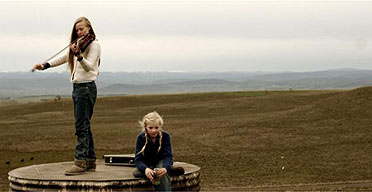“Why don’t clouds float along the ground?” one of the young girls in Jane Campion’s short film “The Water Diary” asks. The film itself meditates on things as unreachable as these: the clouds, a child’s comprehension of all these adult mistakes, and any solution to the environmental disaster these people are enduring.
Campion’s contribution to the United Nations’ 8 film project tackles the seventh goal of the United Nations’ eight Millennium Goals: “ensure environmental sustainability.” Numero Cinq already presented the fifth film, Jan Kounen’s “”The Story of Panshin Beka” (you can see it and the intro here). The film shares a quirkiness with the Jane Campion’s “Passionless Moments” short films which Numero Cinq also presented (you can see them here).
The film places the central issue in the hands and imaginations of children. The child whose diary narrates the film has a perspective limited by her innocence but unlimited by her imagination. She cannot see where the horses have gone at first, her friend calls the central issue “global warning,” and she imagines impossible worlds where there are clouds on the ground and dancing mattresses. So where the adult response to the catastrophe in the film is to have dreams of rain and commit awful sacrifices, the children are able to each take their own small steps and imagine a possible solution.
What fuels the children and this story is the way the children seem to understand sacrifice and pain better than the adults. The horses provide the most visceral and material metaphor for the price these children are paying for their parents’ poor environmental choices. The narrative sees no solution in this sacrifice though, just further adult missteps. As one child warns, “If they think we’re going to look after them when they’re older, they can just forget about it.”
Campion uses extreme long shots to emphasize the landscape and its relationship to the small children in it. The children often appear in the lower corners of the frame or to the side, as in the last shot of the girl playing the viola. Though the children are perhaps diminished, what Campion emphasizes through these shots is how connected these children are to their environment and that small gestures, even single tears in a glass of water, can cause change.
Campion leaves the ending ambiguous. On the one hand what we imagine comes next depends on our own cynicism or imagination. On the other, the point of this story is not the rain, but the spirit, drive and sacrifice to cause change in the world – to fix what has been broken.
–RWGray
